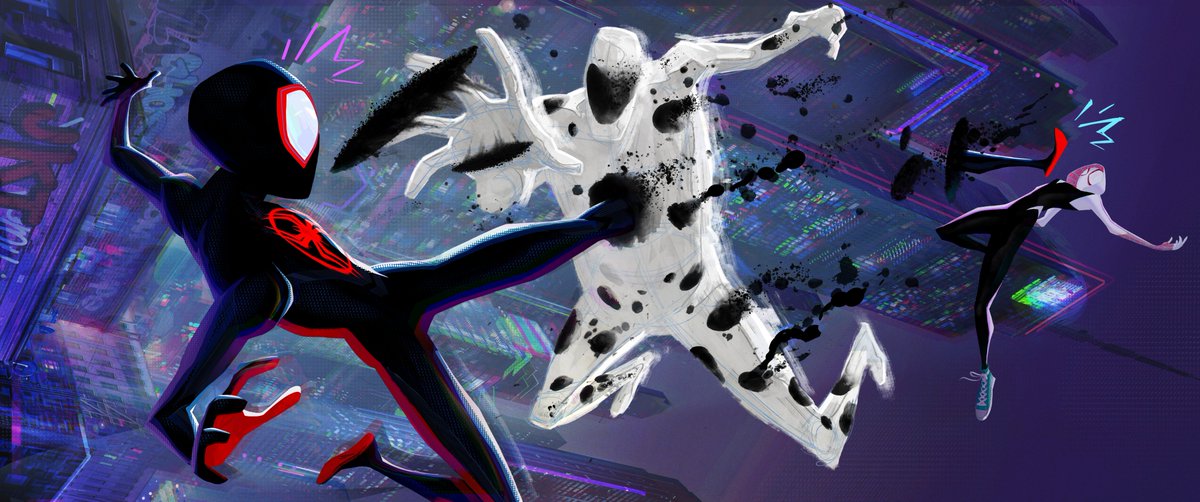Spider-Man: Across the Spider-Verse reaffirms that animation is cinema.
The sequel to the critically-acclaimed Spider-Man: Into the Spider-Verse pushes the boundaries of animation and storytelling to create a movie that’s visually stunning as it is frenetic. In Across the Spider-Verse, Miles Morales (Shameik Moore) has trouble balancing his super-powered duties with his school and personal life. Everyone feels like they know what’s best for him, but ultimately he has an idea of what he wants for himself. However, he doesn’t feel open sharing his identity with his parents Jefferson (Brian Tyree Henry) and Rio (Luna Lauren Vélez). Miles is learning (the hard way) that life comes with sacrifices.
While having to navigate this, Gwen Stacy (Hailee Steinfeld) comes back into his universe and his life, bringing back nostalgia and connection. To make things more fun, she also comes with a new set of super-powered individuals. This crew includes Jessica Drew/ Spider-Woman (Issa Rae), Pavitr Prabhakar/Spider-Man India (Karan Soni), Hobie Brown/Spider-Punk (Daniel Kaluuya), Miguel O’Hara/Spider-Man 2099 (Oscar Isaac), Margo Kess/Spider-Bite (Amandla Stenberg), Ben Reilly/Scarlet Spider (Andy Samberg), and Peter Parker/Spider-Man (Jake Johnson). Of course, they all happen to be a Spider-Hero from their respective universe—or the Spider-Verse, if you will. But being involved with this new Spider-Crew gets Miles wrapped up in a mission to save not just New York City from supervillain the Spot (Jason Schwartzman), but the entire Spider-Verse from impending disaster.
When Into the Spider-Verse first came out, it not only shocked viewers with the quality of animation, but also its storytelling. Thankfully, both elements return in Spider-Man: Across the Spider-Verse. Its predecessor operated as more of an introduction to Miles and an origin story for him. The sequel builds upon his story by highlighting his evolution as a hero, but also as a teenager.

As we all know, with growth comes growing pains. Ultimately, this film is about growing up, becoming your own person, and not letting anyone write your story but you. Across the Spider-Verse is equal parts coming-of-age tale as it is a superhero film. Many of those coming-of-age elements are highlighted through Miles and Gwen’s narratives.
Both characters are navigating challenges in their relationship with their parent(s) and maintaining their secret identities. Miles juggles his parents’ demands and Gwen is stuck balancing a life without community. There’s conflict with her, specifically when it comes to lying to her father, George Stacy (Shea Whigham), about her secret identity—a lie that could severely alter their relationship. Miles and Gwen’s concerns surrounding their identities are a powerful reflection of real-life hardships that teenagers navigate as they discover who they are. Sometimes, those identities come with the risk of rejection by their parents.
This narrative works as a metaphor for when LGBTQ+ kids “ come out” to their parents. Miles shares a moment with his mom that’s similar to coming out as queer. Gwen has a similar scene with her father, but her character and the scene’s coloring is washed in pink, blue, and white, which just so happens to be the transgender flag colors.

Speaking of identity, Across the Spider-Verse creates a world where everyone can exist, especially as a member of the Spider-Society. Each Spider-Hero comes in a diverse array of races, genders, sizes, and abilities with their own rich character development. Even with an immense character collective, Across the Spider-Verse’s writing and directing still allows for plenty of heartfelt storytelling and moments between these characters.
The authenticity of New York City’s culture shines on the big screen. The hustle and bustle of the city is perfectly captured as well as the diversity of communities, specifically Black and Puerto Rican enclaves. Through Miles’ relationship with his parents, viewers see what life is like for folks who are Afro-Latino, biracial/multiracial, and/or multicultural. His family shows that there’s no one right way to express your identities.
From the small bodegas selling beef patties to the massive buildings covered in graffiti spreading throughout the city, Across the Spider-Verse encapsulates the Big Apple’s architectural delights. This film beautifully pulls off the task of recreating dazzling New York City landscapes as well as Spider-Verse versions of the city.

In fact, there’s only one glaring problem with Across the Spider-Verse. It is a tad too long! There’s plenty of ground to cover with various plot points tossed into the air as freely as Spider-Man swings between New York City’s skyscrapers. But while the action and story is jam packed, it’s not overwhelming.
Overall, Spider: Man Across the Spider-Verse‘s thrilling action sequences, beautiful animation, and robust stories will make MCU fans and general moviegoers get lost in a universe that they may not want to escape.
Spider-Man: Across the Spider-Verse swings into theaters on June 2.

